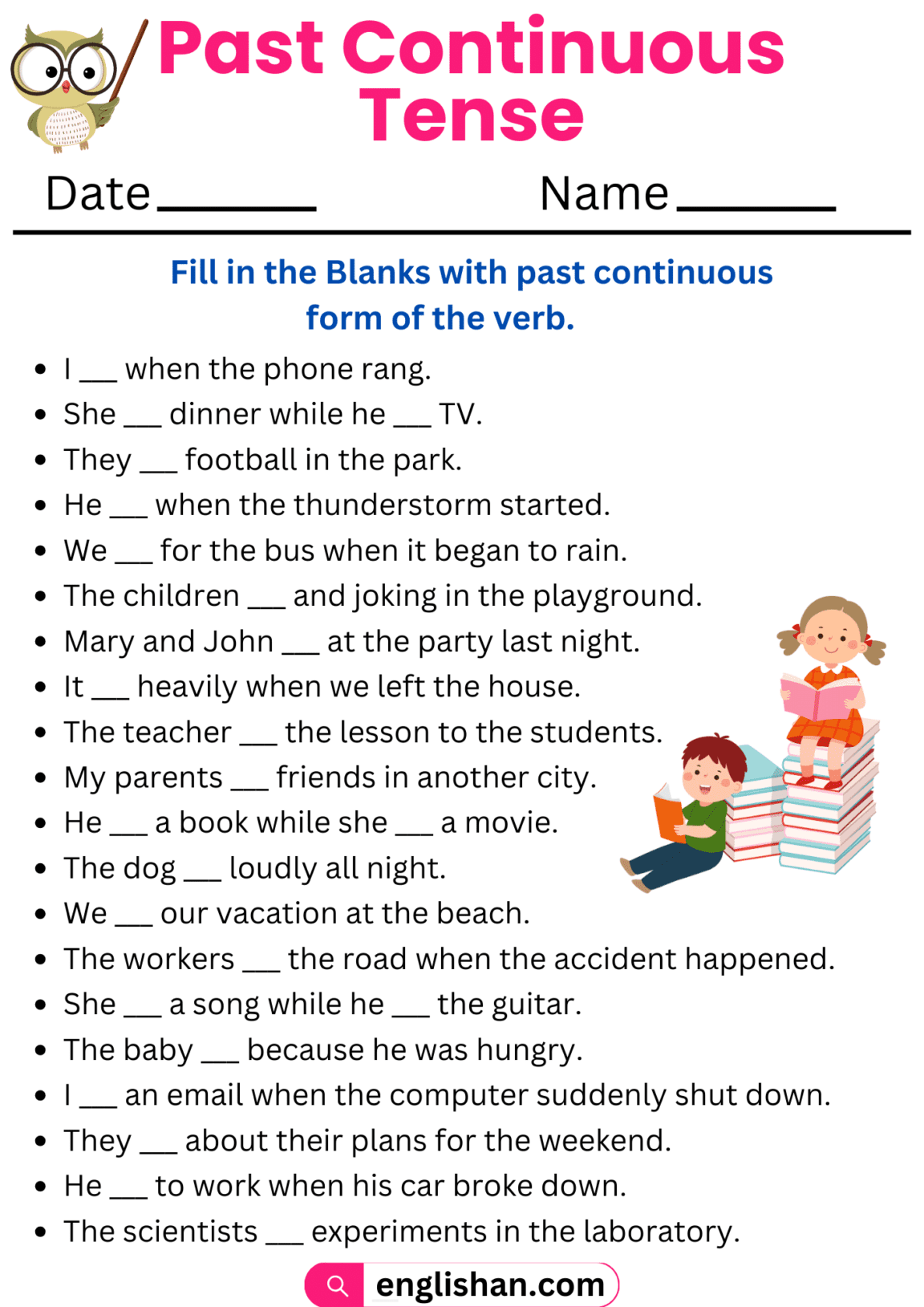
Mastering Time Travel in English: The Power of Grammar Worksheets for the Past Continuous Tense
English grammar, with its intricate tenses and subtle nuances, often feels like a complex puzzle. Among the various pieces, the Past Continuous Tense stands out for its ability to paint vivid pictures of actions unfolding in the past, often interrupted or happening simultaneously with other events. For many learners, grasping this tense – its formation, its various uses, and its distinction from other past tenses – can be a significant hurdle. This is where Grammar Worksheets: Past Continuous Tense emerge as an indispensable tool, transforming abstract rules into tangible, digestible practice opportunities.
This comprehensive article will delve into the profound importance of the Past Continuous Tense, explore the multifaceted benefits of utilizing well-designed grammar worksheets, and provide a detailed guide on creating and effectively using these resources to achieve mastery.

Understanding the Past Continuous Tense: A Snapshot of the Past
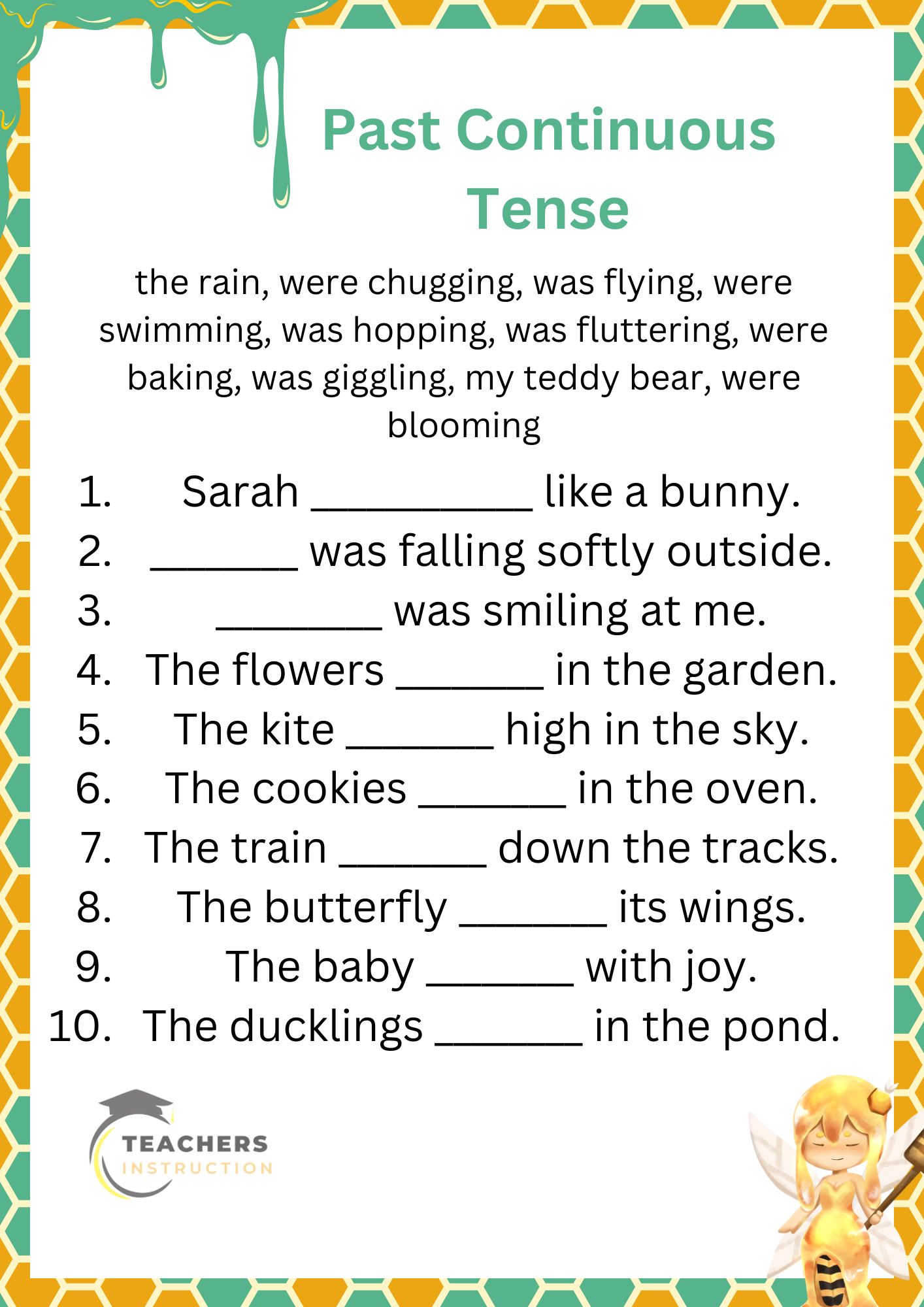
Before diving into the world of worksheets, it’s crucial to solidify our understanding of the Past Continuous Tense itself. Also known as the Past Progressive Tense, it describes an action that was in progress at a specific time in the past, or an action that was interrupted by another event.

Formation:

The basic structure is simple: was/were + verb-ing (present participle).
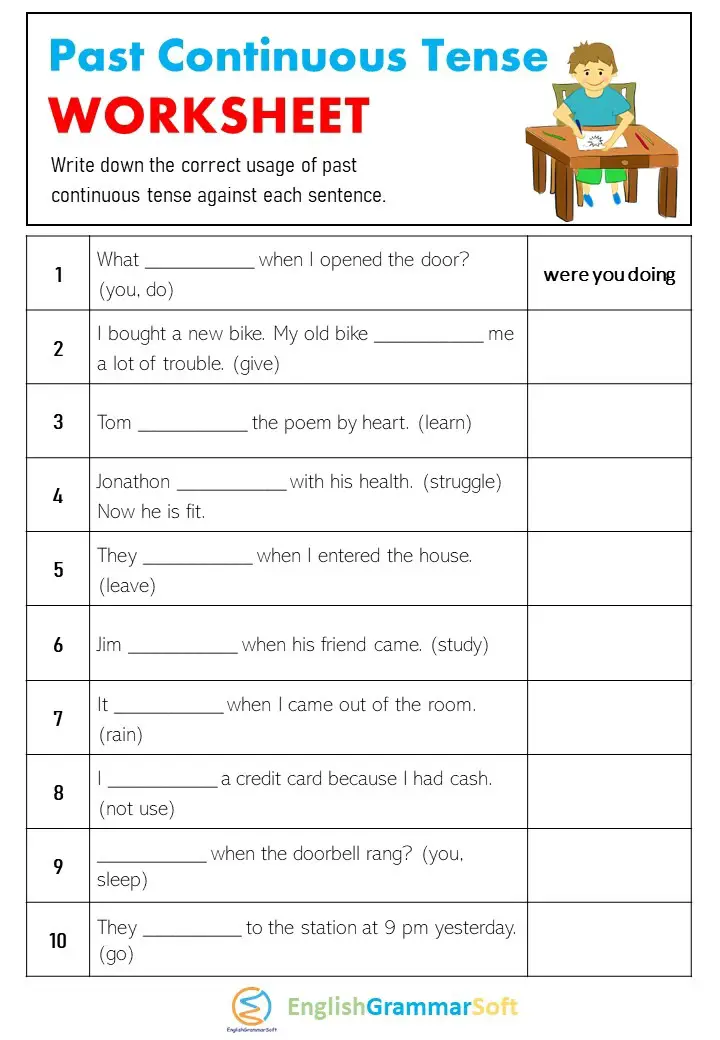
- Positive: I was reading. You were studying. He was playing. They were talking.
- Negative: I was not (wasn’t) reading. You were not (weren’t) studying.
- Question: Was I reading? Were you studying?
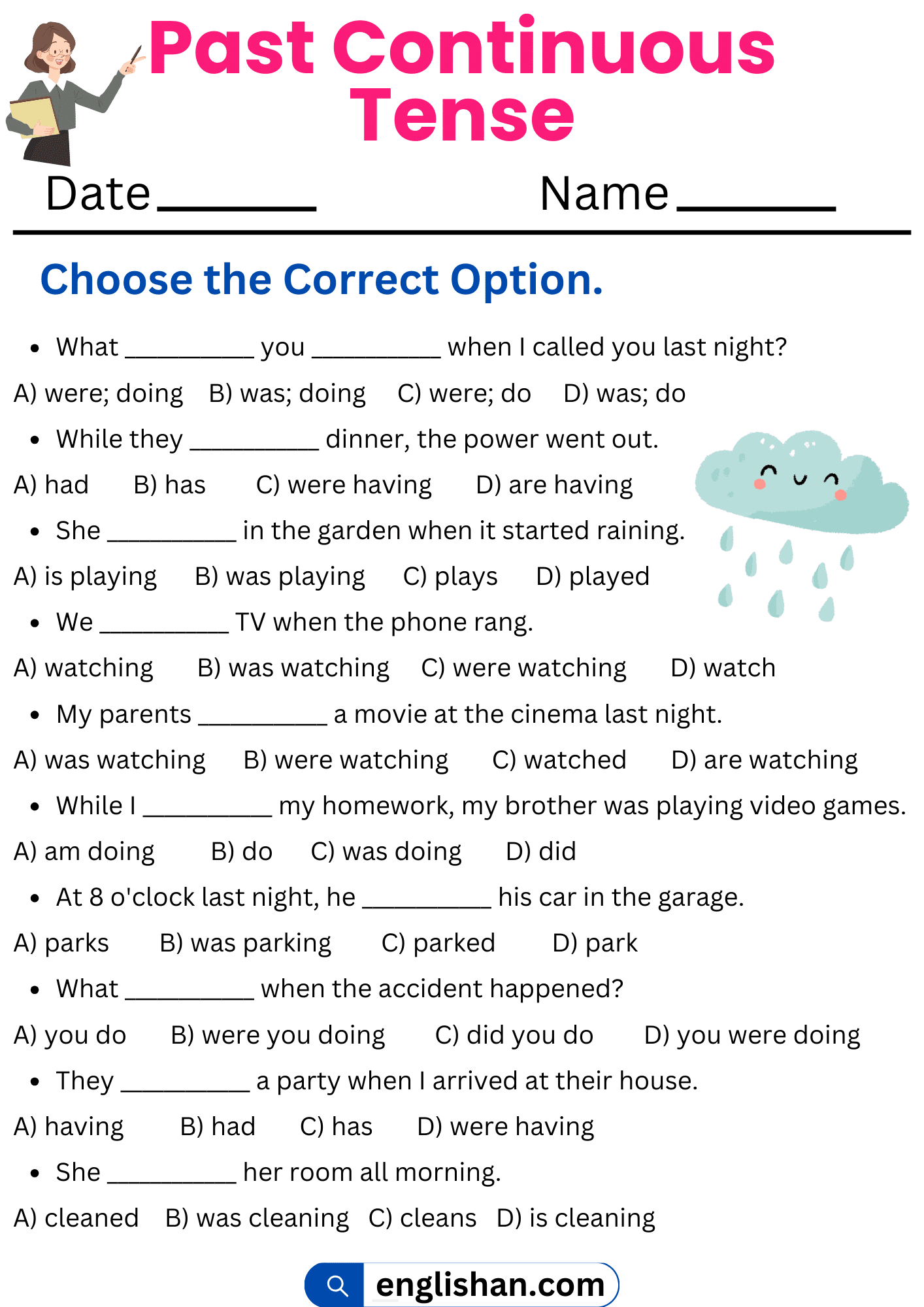
Key Uses and Contexts:
-
Action in progress at a specific time in the past: This is its most fundamental use.
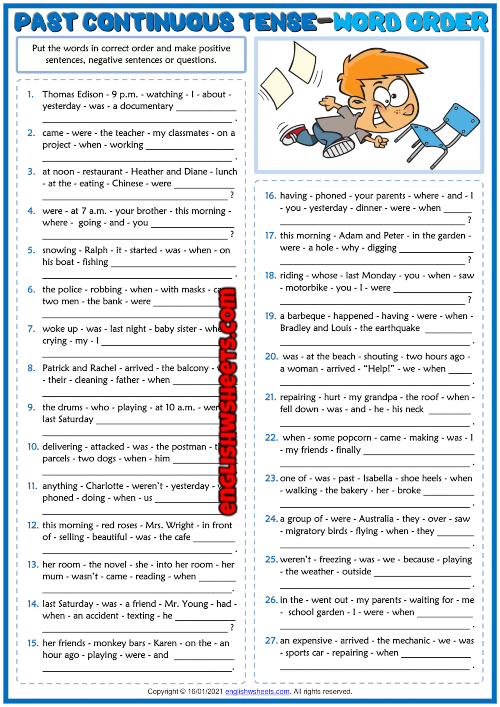
- Example: "At 8 PM last night, I was watching a movie." (The action was ongoing at that precise moment).

-
Interrupted action: This is where it often pairs with the Simple Past Tense, using conjunctions like "when" or "while." The Past Continuous describes the longer, ongoing action, and the Simple Past describes the shorter, interrupting action.
- Example: "I was walking home when it started to rain." (Walking was ongoing; rain interrupted it).
-
Parallel actions: Describing two or more actions happening simultaneously in the past. Here, "while" is a common connector.
- Example: "While I was cooking, my brother was playing video games." (Both actions were happening at the same time).
-
Setting the scene or atmosphere: Often used in storytelling to describe background actions that create a mood.
- Example: "The birds were singing, the sun was shining, and a gentle breeze was blowing."
-
Repeated annoying actions (with ‘always’ or ‘constantly’): Similar to the Present Continuous, but in the past.
- Example: "He was always complaining about his job."
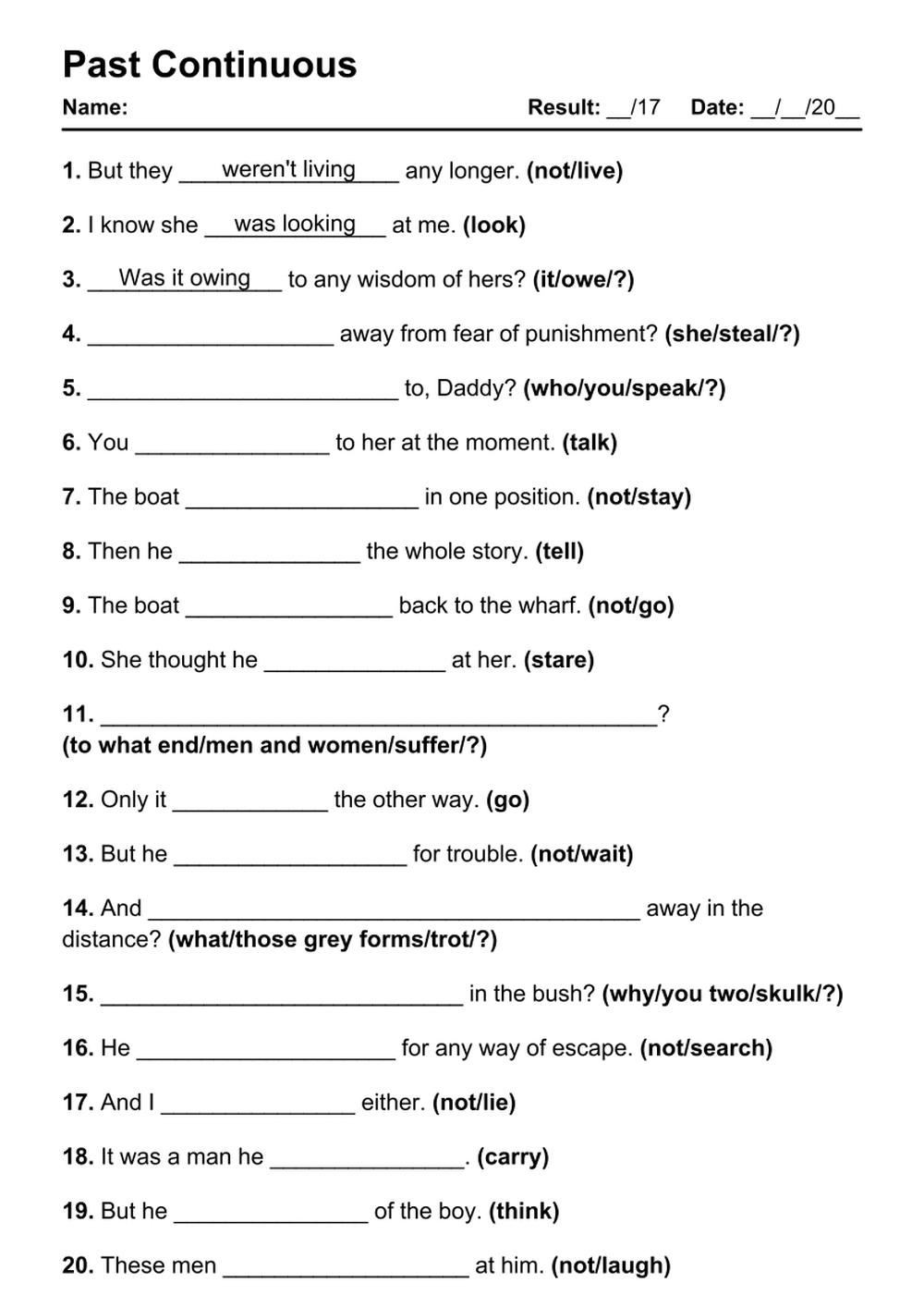
The nuanced distinctions, especially when contrasting it with the Simple Past Tense, make dedicated practice essential. This is precisely where the structured approach offered by Grammar Worksheets: Past Continuous Tense proves invaluable.
The Indispensable Role of Grammar Worksheets
In an age of interactive apps and digital learning platforms, the humble grammar worksheet might seem old-fashioned. However, its enduring efficacy stems from its ability to foster active learning, provide focused practice, and offer immediate feedback – all crucial elements for true language acquisition.
Why are worksheets so effective?
- Active Recall and Application: Unlike passively reading grammar rules, worksheets demand active engagement. Learners must recall the rules and apply them in various contexts, solidifying their understanding.
- Targeted Practice: Worksheets can be designed to focus specifically on one grammar point, such as the Past Continuous Tense, allowing learners to hone in on particular challenges without distraction.
- Repetition for Retention: Repetitive exposure to different sentence structures and scenarios involving the Past Continuous helps embed the patterns in the learner’s mind.
- Error Identification: Worksheets provide a safe space for learners to make mistakes and, more importantly, to identify and correct them. This self-correction process is a powerful learning mechanism.
- Confidence Building: Successfully completing exercises builds confidence, encouraging learners to use the tense more freely in their spoken and written communication.
- Self-Paced Learning: Learners can work through worksheets at their own speed, revisiting difficult sections as needed.
- Measurable Progress: For both learners and educators, completed worksheets offer a tangible record of progress and highlight areas that still require attention.
For a tense as versatile yet specific as the Past Continuous, a systematic approach through Grammar Worksheets: Past Continuous Tense is not just beneficial, but arguably essential for comprehensive mastery.
Designing and Utilizing Effective Grammar Worksheets for the Past Continuous
An effective Past Continuous worksheet is more than just a list of sentences. It’s a carefully crafted sequence of exercises designed to progressively build understanding and application skills.
Key Components and Exercise Types:
-
Basic Formation Drills:
- Fill-in-the-blanks (Conjugation): Simple sentences where students fill in the correct "was/were + verb-ing" form.
- Example: "She _____ (read) a book." -> "She was reading a book."
- Sentence Transformation (Positive/Negative/Question): Students convert given sentences into different forms.
- Example: "They were playing soccer." -> Negative: "They were not playing soccer." Question: "Were they playing soccer?"
- Fill-in-the-blanks (Conjugation): Simple sentences where students fill in the correct "was/were + verb-ing" form.
-
Contextual Usage Exercises:
- Choose the Correct Tense (Past Continuous vs. Simple Past): This is perhaps the most critical exercise type. Provide sentences where students must decide between the two tenses based on context clues like "when," "while," or specific time markers.
- Example: "I (sleep) when the phone (ring)." -> "I was sleeping when the phone rang."
- Sentence Completion (with "when" and "while"): Provide one clause and ask students to complete the sentence using the appropriate tense.
- Example: "While she was studying, her brother _____ (listen) to music."
- Matching Exercises: Match a Past Continuous clause with an appropriate Simple Past interrupting clause or a parallel action.
- Example: Match: "He was cooking dinner" with "when the fire alarm went off."
- Choose the Correct Tense (Past Continuous vs. Simple Past): This is perhaps the most critical exercise type. Provide sentences where students must decide between the two tenses based on context clues like "when," "while," or specific time markers.
-
Application and Creative Exercises:
- Picture Description: Provide an image (e.g., a bustling park, a family scene) and ask students to describe what people were doing at a specific moment in the past. This encourages descriptive language and natural use of the tense.
- Story Prompts: Give the beginning of a story or a series of events and ask students to continue it, focusing on using the Past Continuous to set the scene or describe ongoing actions.
- Example: "Yesterday evening, the wind was howling, and the rain was pouring down outside. Inside, I was sitting by the fire…"
- Error Correction: Present sentences with common Past Continuous mistakes (e.g., incorrect auxiliary verb, wrong verb form, misapplication of usage rules) and ask students to identify and correct them.
- Example: "He was play football yesterday." -> "He was playing football yesterday."
- Interview/Question-Answer: Provide questions using the Past Continuous ("What were you doing at 9 PM last night?"), prompting students to answer in full sentences. This bridges the gap to spoken practice.
-
Integrated Skills:
- Reading Comprehension with Past Continuous: A short story or passage rich in Past Continuous verbs, followed by comprehension questions that require identifying these actions.
- Listening Comprehension: A short audio clip where students listen for and note down actions described using the Past Continuous.
Tips for Effective Worksheet Design and Use:
- Clear Instructions: Ensure every exercise has concise, easy-to-understand instructions.
- Gradual Difficulty: Start with simpler formation exercises and gradually move to more complex contextual and creative tasks.
- Contextual Relevance: Use sentences that are relatable and meaningful to the learners. Avoid abstract or nonsensical examples.
- Visual Aids: Pictures can make worksheets more engaging, especially for descriptive exercises.
- Answer Keys: Always provide an answer key. This empowers learners to self-correct and understand their mistakes, making the learning process more independent.
- Feedback and Review: Whether self-corrected or teacher-marked, take time to review mistakes and clarify any lingering confusion. Encourage learners to articulate why a particular answer is correct.
- Integrate with Speaking/Writing: Don’t let the worksheet be the end. Use it as a springboard for discussion, short writing tasks, or role-plays. For instance, after completing a "Past Continuous vs. Simple Past" exercise, have students create their own similar sentences orally.
The Synergy of Worksheets and Real-World Application
While Grammar Worksheets: Past Continuous Tense are fundamental for building a solid grammatical foundation, their true value lies in how they prepare learners for real-world communication. A student who has diligently worked through a variety of exercises will be better equipped to:
- Narrate Past Events: Confidently describe what they were doing at a specific time or when an event occurred.
- Tell Engaging Stories: Use the Past Continuous effectively to set scenes, describe background actions, and build suspense in their narratives.
- Understand Spoken English: Comprehend native speakers who use this tense naturally in conversations about past experiences.
- Write Clearly and Coherently: Produce written pieces that accurately convey the progression and interruption of past actions.
The consistent, targeted practice provided by well-crafted Grammar Worksheets: Past Continuous Tense bridges the gap between theoretical knowledge and practical application. They transform the often-daunting task of learning grammar into a structured, manageable, and ultimately rewarding journey.
Conclusion
The Past Continuous Tense is a vital component of English, enabling speakers and writers to describe dynamic past scenarios with precision and clarity. While its rules might initially seem complex, the path to mastery is significantly smoothed by consistent, targeted practice. This is precisely the role of well-designed grammar worksheets.
From basic formation drills to complex contextual exercises and creative application tasks, Grammar Worksheets: Past Continuous Tense offer an unparalleled opportunity for learners to internalize the structure and usage of this crucial tense. They empower learners to actively engage with the material, identify and correct their own errors, and build the confidence necessary to apply their knowledge in real-life communication. So, embrace the power of the worksheet, and unlock the full potential of the Past Continuous Tense in your English language journey.
